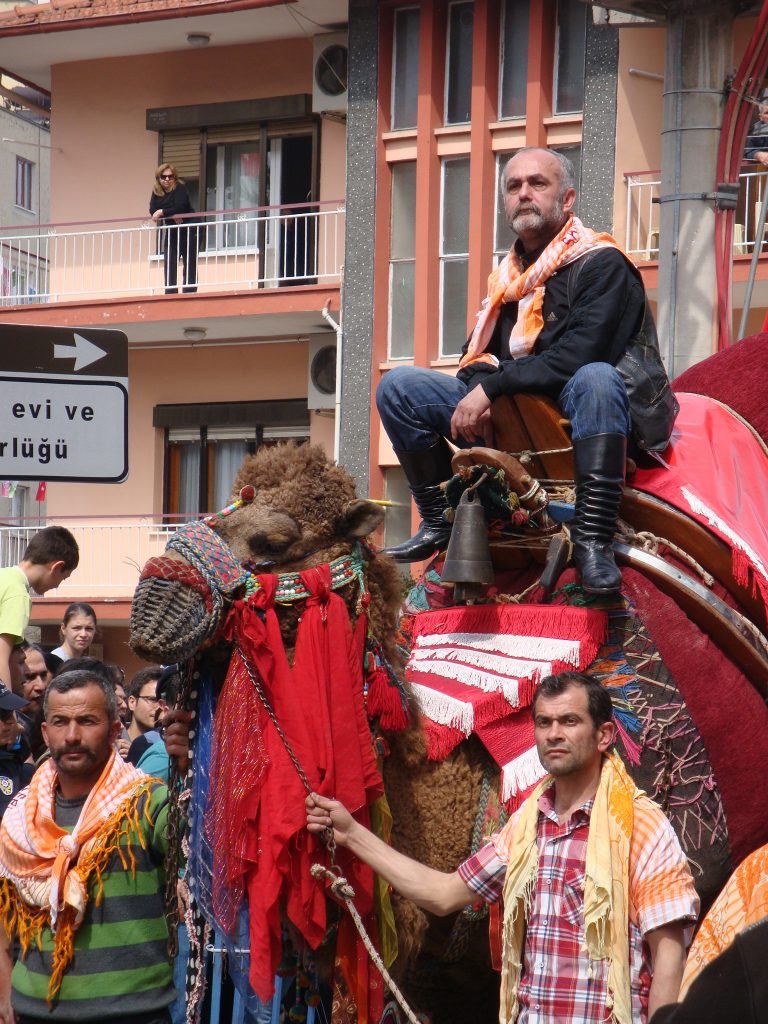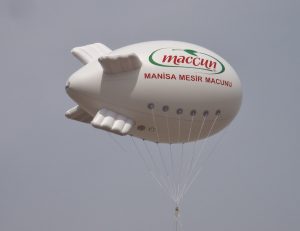 Once upon a time there was an Ottoman princess. Or rather there was a queen mother (valide sultan) who was just as important. But now the princess/queen mother had fallen ill and nothing the physicians could do would restore her. Then along came a local miracle-worker called Merkez Efendi who whipped up a paste of 41 different ingredients. He administered this mesir macunu to the princess/queen mother and, hey presto, she was on the road to recovery.
Once upon a time there was an Ottoman princess. Or rather there was a queen mother (valide sultan) who was just as important. But now the princess/queen mother had fallen ill and nothing the physicians could do would restore her. Then along came a local miracle-worker called Merkez Efendi who whipped up a paste of 41 different ingredients. He administered this mesir macunu to the princess/queen mother and, hey presto, she was on the road to recovery.
That princess was Hafsa Sultan, the wife of Selim the Cruel and mother of Süleyman the Magnificent (known as Süleyman the Lawgiver to the Turks). Thus were born celebrations that have been taking place in Manisa for the past 472 years.
Focal point of these celebrations is the the tossing of mesir macunu from between the domes of the Sultan Medresesi although it proved frustratingly difficult to get hold of exact details from afar. In the way of things modern what was once a one-day event has acquired an elasticity that meant Manisa would be en fete for most of the week following Nevruz, the traditional Middle Eastern spring holiday.
They’ll toss the macun on Saturday, I thought, that being a very Western choice of days for celebration. Further enquiries suggested that, no, actually Sunday would be the big day. After noon prayers, I was told, except that this was the weekend when the clocks would go forward, shunting noon prayers to 1 pm. Arriving in Manisa at 11.30 am I was shocked to see posters advertising the actual start time as 1.45 pm which meant having to hang about for more than two hours.
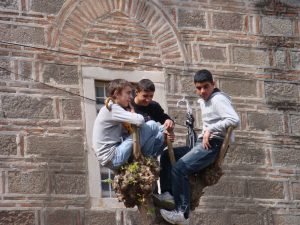 To while away the time I took a quick turn around Ulu Parkı where stalls selling a motley array of goods and foodstuffs were on sale. Then I ambled up the road to the mosque and was surprised to find the entire town centre cordoned off and crawling with police. Already the crowd was gathering. Mysteriously some men had taken up positions amid the pollarded branches of trees lining the road in front of the medrese. Most of them were young enough to get away with such tomfoolery although there was one man of a certain age who really should have known better. Gazing up at the roof of the medrese I could see men arranging Santa sacks of macun. In the park behind them police officers already exhausted by their exertions were tucking into packed lunches beneath the stern gaze of a bust of Hafsa Sultan.
To while away the time I took a quick turn around Ulu Parkı where stalls selling a motley array of goods and foodstuffs were on sale. Then I ambled up the road to the mosque and was surprised to find the entire town centre cordoned off and crawling with police. Already the crowd was gathering. Mysteriously some men had taken up positions amid the pollarded branches of trees lining the road in front of the medrese. Most of them were young enough to get away with such tomfoolery although there was one man of a certain age who really should have known better. Gazing up at the roof of the medrese I could see men arranging Santa sacks of macun. In the park behind them police officers already exhausted by their exertions were tucking into packed lunches beneath the stern gaze of a bust of Hafsa Sultan.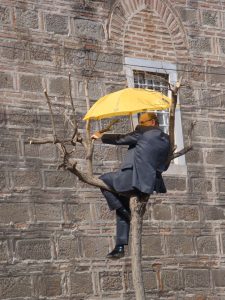
Taking a quick turn around the cordoned-off area, I spotted more men standing on the roof of the shrine to Saruhan, the founder of the beylik that governed this part of Turkey after the collapse of the Selçuk supremacy. On the traffic roundabout children were clambering over the statue of Merkez Efendi and his magic box of macun as if it were a fairground attraction while just down the road the shops that normally sell macun anyway had gone to town with posters covering entire apartment blocks and a giant blow-up Ottoman mannequin jerking from side to side on the pavement. From loudspeakers in front of the mosque an annoyingly catchy jingle played over and over again. The sense of anticipation was palpable.
Then suddenly a roar heralded the start of an unexpected costume parade. The macun aside, Manisa’s second claim to fame is that it was the Şehzadenin Şehri (City of the Princes), one of the places to which early contenders for the Ottoman sultanate were sent to learn statecraft. So now along came a prancing procession of men on horseback, all dolled up in pseudo-Ottoman finery and carrying name plates that identified them as the princes who had gone on to become sultans. Behind them in carriages came the women of their harems. Bringing up the rear were two sniffy-looking Aegean fighting camels and a selection of folk dancers from all around the Balkans.
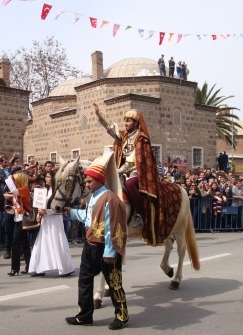 The festivities came to a brief halt while the dignitaries vanished into the mosque to pray, then kicked off again on the stroke of 1.45 pm by which time the crowd was as hyped-up as one for a Galatasaray-Fenerbahçe derby. There followed an excruciating fifteen minutes while a succession of dignitaries bored us with the same potted history of the revelry while the crush of bodies against the crash barriers grew ever more alarming. Only short speeches by the ersatz Mehmet II (very fashionable at the moment with Fethi 1453, the film about his conquest of Constantinople. packing out cinemas countrywide) and the faux Süleyman the Magnificent roused the crowd to a cheer.
The festivities came to a brief halt while the dignitaries vanished into the mosque to pray, then kicked off again on the stroke of 1.45 pm by which time the crowd was as hyped-up as one for a Galatasaray-Fenerbahçe derby. There followed an excruciating fifteen minutes while a succession of dignitaries bored us with the same potted history of the revelry while the crush of bodies against the crash barriers grew ever more alarming. Only short speeches by the ersatz Mehmet II (very fashionable at the moment with Fethi 1453, the film about his conquest of Constantinople. packing out cinemas countrywide) and the faux Süleyman the Magnificent roused the crowd to a cheer.
Then at last it was time. Up on the roof police marksmen and local officials had been joined by men in long Ottoman cloaks and tall felt hats. To screams of approval from the crowd they cut open the sacks and started tossing handfuls of macun in toffee-paper wrappings into the air while the volume of the “Eller Havaya” jingle was turned up to deafening pitch. The crowd went as wild as if it were attending the first day of the Harrod’s sale, despite the fact that just down the road packets of macun were on sale from a myriad stalls for a mere TL10.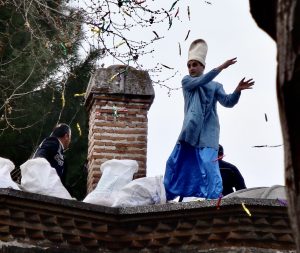
Earlier in the afternoon I’d watched in bemusement as people unfurled umbrellas despite the absence of a cloud in the sky. Now I realised that this was a clever ploy to increase the likelihood of scooping up macun. Never slow to miss a marketing opportunity, Turkcell had rushed out a line in yellow brollies embossed with telltale antennae logos. In the branches of the pollarded trees men lunged with their umbrellas like fishermen on the Galata Bridge. Across the road the residents of top floor apartments had gathered up their own stock of macun. As they tossed it into the air their neighbours on the floors below lent out from the balconies to catch it in their umbrellas.
Sadly, it doesn’t take much time to empty even the biggest collection of sacks of mesir macunu. In just over quarter of an hour it was all over. Shortly afterwards the “Ottomans’ on the roof were hitching up their robes and struggling down the ladders while the crowd melted away down the high street clutching its booty as if it were gold dust.
Written: 1 April 2012
